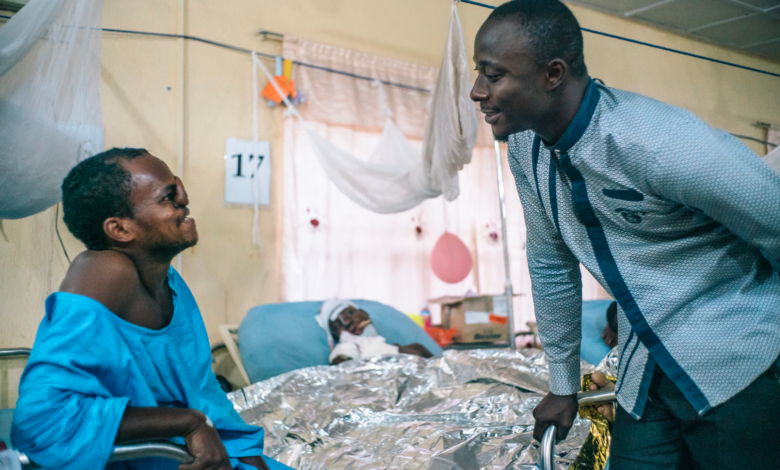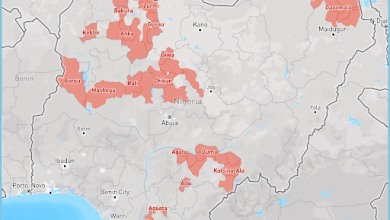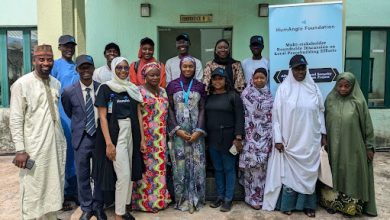Fatal Face-Eating Noma Disease Worsened By Malnutrition In Nigeria’s Northwest
Noma is a little known fatal disease that is preventable and treatable. It affects the mouth and gums spreading rapidly, destroying facial tissues and bones.

A little-known and deadly face-eating disease is spreading because malnutrition is so prevalent in the northwestern region of Nigeria, medical authorities say.
Noma disease is a gangrenous facial infection. It is caused by a bacteria that affects the gums and mouth, spreading rapidly in a way that destroys facial tissues, including bone, says Dr Mark Sherlock, health advisor of Médecins Sans Frontières/Doctors Without Borders (MSF) in Nigeria.
“Malnutrition is one of the known causes of Noma,” Dr Sherlock says in a phone interview, adding that “it affects people with low immune systems living in abject poverty who do not have access to clean water and health care facilities. These together are the risk factors surrounding the disease.”
Noma
The first sign of Noma disease is the inflammation of the gums which is known medically as gingivitis. It gradually progresses to “necrotising gingivitis” where the tissues in the mouth swiftly start to die. Then it becomes severe to the extent the infected persons’ face starts to swell.
Dr Sherlock explains that once the face starts swelling the disease is reaching a critical level. Unless treated, the facial tissues of those infected will be eaten up by the disease.
“At that stage it becomes almost fatal and if the infected person is able to survive, they have terrible facial scarring and deformities, patients finding it hard to eat when they get locked jaws. The patient is only able to open their mouths a few centimetres,” Dr Sherlock adds.
Noma affects children and adults in the same way but it is more common between children aged between two and seven years old. “Children contract it during the weaning process,” Dr Sherlock says.
Babies who are weaned off breast milk and start taking solid food prepared in unsanitary environments are prone to contracting Noma.
Almost 90 per cent of children who get the infection die within days.
Noma is more prevalent in the northwestern part of Nigeria where MSF has recorded unprecedented levels of malnutrition cases especially in children. Other risk factors of Noma include the outbreak of measles infections and malaria infections, Dr Sherlock says, adding that other risk factors are still unknown.

Noma treatment in Sokoto
Due to the large burden of Noma in northwest Nigeria, the country took the step to set up a Noma clinic in Sokoto state in 1999. MSF began supporting the clinic in 2014.
In the early stages, treatment of Noma consists of medical professionals cleaning the mouth and gums, as well as putting infected patients on Antibiotics. When Noma reaches severe stages, treatment may consist of reconstructive surgery, Dr Sherlock says, it might take up to 10 or more reconstructive surgeries for people to completely heal.
MSF carries out four Noma interventions annually where they offer reconstructive surgeries for 120 – 150 infected persons in a year. So far, surgical teams have carried out 1,066 surgeries on 717 patients, however, these figures do not account for the infection rate of the disease.
The statistics and data around Noma cases and its fatality rate cannot be quantified due to it disproportionately affecting rural populations. Dr Sherlock notes that about 90 per cent of infected people die of the disease before they can get adequate medical help.
The disease is also little known which underestimates the number of cases, he says, “because of the little awareness of the disease, not only in Nigeria but globally, it is often classified as something else like necrosis or cancer, and they are not really recorded as Noma because people don’t know Noma.”
After surgeries are successfully done, MSF teams discharge patients with after care kits including supporting nutrition for a while after. “For patients to heal properly after surviving Noma they would need nutrition, so we discharge patients with nutrition packages,” Dr Sherlock explains.
Plans for more awareness on Noma
Currently, MSF is urging the World Health Organisation (WHO) to include the life-threatening Noma into the Neglected Tropical Diseases (NTDs) list. Putting the disease on the list would increase awareness of it and the methodologies to prevent it.
Neglected Tropical Diseases are a conglomerate of diseases that are said to disproportionately affect low-income populations.
Through the decade, the WHO has made steps towards public health approaches against NTDs and implemented disease control and prevention efforts in endemic areas.
MSF noted that after a three-year international advocacy and communication campaign, a representative from the Federal Ministry of Health of Nigeria shared the dossier on Noma with WHO offices in Abuja, Nigeria’s capital.
In a press statement, the MSF notes that the WHO will take the final decision on whether to add Noma to its list of neglected tropical diseases during one of its biannual meetings in 2023.
Support Our Journalism
There are millions of ordinary people affected by conflict in Africa whose stories are missing in the mainstream media. HumAngle is determined to tell those challenging and under-reported stories, hoping that the people impacted by these conflicts will find the safety and security they deserve.
To ensure that we continue to provide public service coverage, we have a small favour to ask you. We want you to be part of our journalistic endeavour by contributing a token to us.
Your donation will further promote a robust, free, and independent media.
Donate HereStay Closer To The Stories That Matter





Noma disease…a disease that should not exist. Glad to be part of this global campaign. Thanks to medecins sans frontier that is given so much plant form to serve the humanity. Kudus to the mental health team restoring dignity